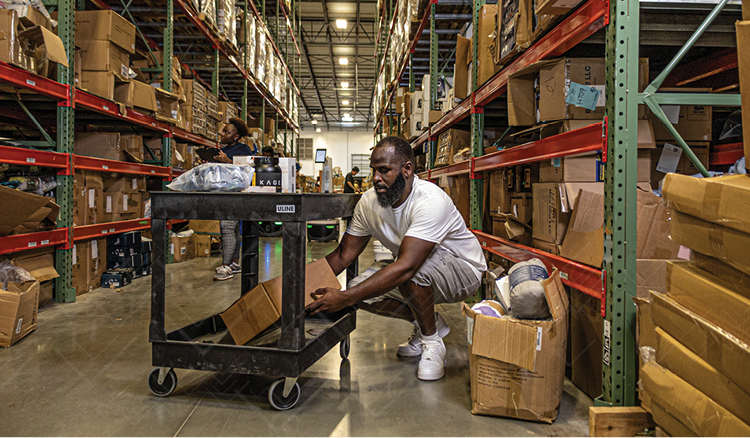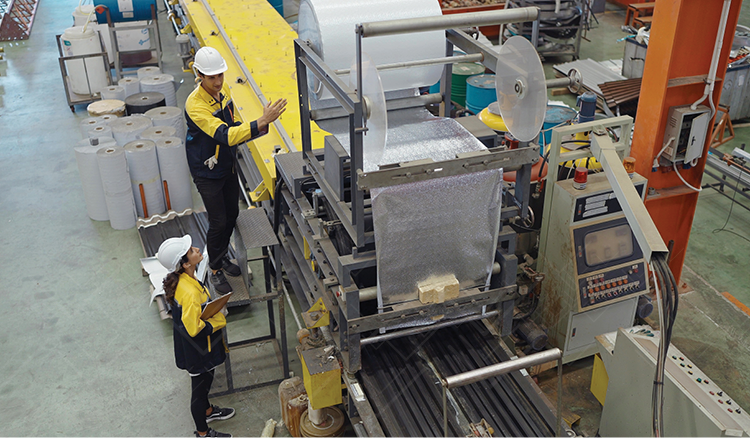Looking Ahead to 2024 in Manufacturing
The landscape of manufacturing has undergone a dynamic shift over the past year, marked by significant developments and contrasting trends. There has been great investment by the Biden administration evident through the enactment of pivotal legislation such as the Infrastructure Investment and Jobs Act (IIJA), the Creating Helpful Incentives to Produce Semiconductors and Science Act (CHIPS), and the Inflation Reduction Act (IRA). Concurrently, the industry has navigated the challenges of a fluctuating economy, including a historic surge in interest rates, soaring nearly 500 basis points in a span of 14 months.
So, where does the industry stand today? That's the question and a conversation with an industry executive would likely reveal a prevailing sense of positive momentum despite ongoing headwinds. Looking forward to 2024, there is palpable excitement fueled by a historic influx of both public and private investments in the sector. This era of unparalleled commitment is likely to address longstanding issues such as inflationary pressures and supply chain disruptions, with the impact of these investments unfolding over the next decade. This could well be the decade of manufacturing -- a period of growth and transformation that has not been witnessed before.
Navigating Evolving Challenges in Demand and Regulatory Landscape
Many of the issues that caused significant apprehension in 2022 have notably diminished in importance. Primary among these were post-COVID supply chain disruptions, general price inflation, and transportation costs, all of which have moderated. Consequently, surveys of manufacturing leaders reveal a substantial reduction in the level of concern these challenges elicited by the mid-year point in 2023. Instead, a more generalized apprehension has emerged, focusing on demand and the expenses linked to regulatory compliance.
On the demand front, data from the first half of 2023 indicate resilience in consumer spending, supporting growth and mitigating recession concerns, at least until midyear. However, the backing provided by excess savings from stimulus measures and the temporary pause in student loan debt service is reaching its conclusion. Diminished consumer support, coupled with fears of an inflation resurgence, could pose challenges in 2024. Additionally, regulatory issues continue to be a major worry, especially considering their rapid expansion in both scope and complexity across virtually all operational domains. Anticipating a reduction in this burden for U.S. manufacturers in the near term seems unlikely; if anything, the complexity and costs are expected to rise from current levels, presenting challenges for manufacturers, particularly smaller and middle-market companies.

(Source: National Association of Manufacturers, Nam Manufacturers' Outlook Survey (January 2023 and June 7, 2023))
Talent Obstacles Continue to be Persistent
The tight labor market observed throughout 2023 is expected to persist into 2024 (see figure below). A recent survey by the National Association of Manufacturers (NAM) reveals that nearly three-quarters of surveyed manufacturing executives view the attraction and retention of a high-quality workforce as their primary business challenge. This concern is further compounded by the fact that, according to Deloitte's 2022 findings, nearly one-third of the manufacturing workforce was 55 years or older, with Baby Boomers retiring at a rate of around 10,000 per day. Unfortunately, younger generations have exhibited limited interest in pursuing careers in manufacturing. Consequently, Manufacturers are trying to (a)maintain connections with retired alumni and (b) attract new workers.
Addressing this challenge, manufacturing firms have proactively adjusted their workforce policies to enhance employee attraction and retention. Notably, these changes include:
Prioritizing flexibility: A NAM survey indicates that 46.8% of manufacturing executives surveyed provide flexible scheduling options to production workers. This flexibility extends to remote work, compressed workweeks, and the ability to swap or split shifts.
Employee recognition: Deloitte's analysis reveals a 4% increase in the average hourly earnings of manufacturing employees between Q1 FY2022 and Q1 FY2023. Concurrently, there has been a notable 19% reduction in the average number of voluntary separations during the same period.

(Source: Deloitte analysis of Bureau of Labor Statistics data)
Despite these positive adjustments, manufacturers must continue exploring additional strategies in 2024 to further enhance talent attraction and retention amid a competitive labor market. One such strategy involves integrating Veryable into the hiring process. Veryable operates as a marketplace connecting manufacturers with skilled and well-reviewed Operators, who function as independent contractors. This model stands apart from traditional staffing methods and offers a significant improvement over conventional hiring techniques.
Veryable's tech-enabled approach aligns with evolving workforce expectations, providing autonomy to Operators over their terms, schedules, and workloads. In contrast to rigid arrangements imposed by staffing firms, Veryable empowers Operators to take ownership of their work, offering manufacturers flexibility while enhancing overall workforce satisfaction. Therefore, incorporating Veryable into the hiring strategy is crucial for manufacturers navigating the challenges of a tight labor market in 2024.
Challenges with Regulations Remain a Concern
Concerns persist regarding regulatory challenges. Government regulators have intensified their oversight of private businesses across various sectors, including manufacturing. Industry leaders consistently identify government regulations as a key obstacle, particularly noting the disproportionate impact on middle-market and smaller enterprises that lack the resources to efficiently address compliance requirements and manage associated costs. Unfortunately, there is little indication that these challenges will ease in the near future.
The 2023 KPMG Chief Ethics & Compliance Officer Survey underscores the prevalent perception of "increasing regulatory expectations and scrutiny," with 73 percent of respondents expressing this concern. Notably, a mere three percent anticipate a reduction in the workforce dedicated to compliance functions.

(Source: National Association of Manufacturers, The Cost of Federal Regulation to the U.S. Economy, Manufacturing and Small Business)
As discussed in a previous blog we posted, a well-balanced regulatory approach in 2024 and beyond is imperative. Achieving this balance necessitates collaboration among government agencies, industry leaders, and advocacy groups. Prioritizing policies that strike a harmony between public interest and economic growth becomes crucial. Legislative and administrative reforms, aimed at streamlining regulatory processes, eliminating redundancies, and alleviating the compliance burden on manufacturers, are pivotal. Creating an environment where businesses can flourish, innovate, and contribute to economic prosperity, all while maintaining high standards of safety and sustainability, relies on these necessary changes.
Union Activity, the NLRB, and the Expansion of Section 7
As of December 5th, 2023, the Cornell labor action tracker reports a total of 40 strikes, indicating a 21 percent increase compared to the same period in the previous year. Despite the popular narrative concerning a renaissance of organized labor, the 2022 overall union membership rate remains at a low of 10.1%. Still, public policy and regulations have not shifted in favor of management. A notable example is the National Labor Relations Board's ("NLRB") introduction of new obligations for employers in August 2023 when faced with a union's voluntary recognition demand.

(Source: U.S. Bureau of Labor Statistics)
In a landmark decision (Cemex Construction Materials Pacific, LLC, 372 NLRB No. 130, 2023), the NLRB overturned a longstanding precedent, Linden Lumber Division, Sumner & Co., 190 NLRB 718 (1971). Under the new standard, employers must either agree to recognize the union or, if refusing, promptly file a petition within two weeks to challenge the union's majority support or the appropriateness of the bargaining unit. Failure to do so may result in a violation of the National Labor Relations Act ("NLRA") and could lead to a bargaining order.
During the critical period from the demand for recognition to the election preparation, unfair labor practices by the employer may lead to the dismissal of the petition and an order compelling the employer to bargain with the union. Notably, the NLRB applied this standard retroactively in the Cemex case, overturning the election results and mandating bargaining with the union.
The NLRB's decision in Cemex is not an isolated development but aligns with the Biden administration's pro-labor approach. The Board's 2023 decisions consistently favor organized labor interests by expanding the scope of "protected concerted activity" under Section 7 of the NLRA. For instance, the decision in Stericycle, Inc. and Teamsters Local 628 (372 NLRB No. 113, 2023) challenged an employee handbook policy, deeming it a violation of rights. The NLRB's new standard views employer policies presumptively as unlawful if they could be interpreted as infringing on employees' rights, with employers having to prove a legitimate business interest to rebut this presumption.
This evolving interpretation of Section 7 rights poses challenges for employers, especially in industries where considerations of employee safety and managing multiple concerns on the shop floor are critical.
Workplace Safety
Historically, the primary realm of federal legal restrictions imposed on manufacturers has been in the domain of workplace health and safety regulation. As the year 2023 commenced, the Occupational Safety and Health Administration ("OSHA") was actively augmenting the already substantial body of regulations. Additionally, they formalized collaboration with the NLRB through a memorandum of understanding, aiming to bolster cross-agency consultations, training, outreach, and education.
With nearly two dozen regulations at various stages of rulemaking on its annual agenda, OSHA is actively progressing rules that may pose challenges for many manufacturers. An illustrative example is OSHA's recent endorsement of a policy allowing regional offices to issue Instance-By-Instance (IBI) citations during a single investigation, each addressing a separate violation. These citations could entail distinct penalties, adding to compliance costs and insurance claims associated with workplace injuries. Liberty Mutual Insurance estimates that the manufacturing industry experiences an annual loss of around $8.32 billion due to serious, non-fatal workplace injuries.

(Source: Liberty Mutual Insurance Company)
In August, OSHA also introduced new rules permitting non-employee representatives during its inspections, provided their presence is deemed "reasonably necessary" for an effective and thorough inspection. Additionally, the rulemaking revived OSHA's pursuit of granting non-unionized workers the ability to designate outside third parties affiliated with a union as their representatives during inspections. This approach, initially outlined in the 2013 Fairfax Memo, drew criticism from employers who viewed it as an attempt to use OSHA inspections as a covert means to unionize outside of traditional bargaining processes. Although OSHA rescinded the Fairfax Memo in 2017 after a legal challenge by the National Federation of Independent Business, it appears that the agency is revisiting the idea of integrating organized labor into non-unionized establishments.
Trends to Watch
*Predictive maintenance and digital twin technology. The cost of downtime because of inefficient maintenance can be staggering for leading manufacturers. For example, large plants lose 323 production hours a year and the average cost of lost revenue, financial penalties, idle staff time, and restarting lines is $532,000 per hour, amounting to $172 million per plant annually.
That’s where predictive maintenance comes in. Predictive maintenance uses data analyses tools and techniques to predict possible defects in equipment and processes to help you fix them before they result in failure. Predictive maintenance can result in a 40% reduction in maintenance costs, a 70% decrease in downtime, and a 25-30% increase in overall equipment effectiveness (OEE). The Predictive Maintenance Market size is expected to grow to $15.9 billion USD by 2026, at a CAGR of 30.6%.
The growth of AI, IoT, and Big Data has also made way for a trend called “digital twins.” Digital twin manufacturing is a concept that uses a digital replica or “twin” of a physical manufacturing process or system. This digital model mimics the behavior and performance of its physical counterpart in real-time, providing valuable insights and enabling better decision-making. The digital twin market is expected to reach $73.5 billion by 2027.
*Continued Reshoring. Global issues like the war in Ukraine and the COVID-19 pandemic continue to cause supply chain disruption and it doesnt appear to be getting any better anytime soon. Manufactuers are having to make the best and bring production home. According to The Reshoring Initiative report, more than 364,000 reshoring and FDI jobs were announced for 2022, up 53% from the previous record of 238,000 set in 2021.
There are many benefits to reshoring, including:
(1) Reduced Transportation Costs: When manufacturing is done domestically, the costs and time associated with transporting goods internationally are significantly reduced. For example, car manufacturers like Tesla benefit from reshoring by producing cars closer to their main market, reducing logistics costs and time.
(2) Quality Control: Reshoring allows for closer oversight and higher control over production processes, ensuring a consistently high-quality product. Apple, for example, has brought some of its manufacturing back to the United States to tightly control the quality of its products.
Speed to Market: Domestic manufacturing can significantly reduce the lead time from production to market, allowing for quicker responses to market changes. When faced with sudden demand for ventilators during the COVID-19 pandemic, many US companies were able to pivot and produce them domestically, demonstrating the agility of reshored manufacturing.
Reshoring + FDI Job Announcements by Year, 2010 - 2023 Projected

(Source: Reshoring Initiative, 2023 1st Half Reshoring Report)
(3) Local Job Creation: Reshoring can stimulate local economies by creating jobs. General Electric, for instance, reshored some of its appliance manufacturing operations to Kentucky, creating several hundreds of jobs and boosting the local economy.
Expect this trend to continue as companies look to become more resilient and less vulnerable to global crises that impact their supply chain.
*Continued Pursuit of Supply Chain Resilience. The inquiry into enhancing supply chains and fortifying their resilience remains prominent. Tune in to any earnings call, and the prevalent discussion revolves around the scarcity of components or delays in deliveries. 2024 may be no different, with business leaders persistently dedicating themselves to bolstering supply chain resilience. They will actively seek innovative solutions, including the integration of AI, to facilitate substantial advancements. Concurrently, there will be an unwavering emphasis on cost-effectiveness. In the backdrop of economic uncertainties and central banks increasing interest rates to combat inflation, leaders may face demands for elevated profit margins in their enterprises. Achieving this objective will necessitate a continued reliance on traditional, cost-focused sourcing and procurement compliance.
Conclusion
The manufacturing sector has experienced significant shifts and challenges in the past year, marked by substantial investments, regulatory changes, and persistent issues such as a tight labor market. While the industry exhibits positive momentum and excitement for 2024, ongoing concerns include demand uncertainties, regulatory complexities, and talent shortages. Proactive adjustments in workforce policies and innovative approaches like integrating Veryable are crucial for navigating these challenges. The evolving landscape of organized labor, workplace safety considerations, and emerging trends such as predictive maintenance and reshoring add further complexity. Despite these challenges, the convergence of investments, regulatory reforms, and technological advancements positions the industry for a decade characterized by growth, innovation, and resilience.
Previous Posts
How Policy Constraints, Not Just Production Bottlenecks, Threaten Your Bottom Line
The Future of Manufacturing and Logistics
Create a free business profile today to explore our platform.






